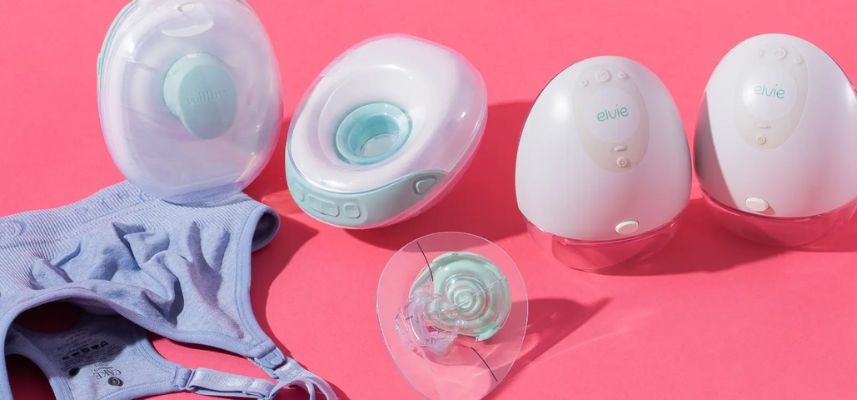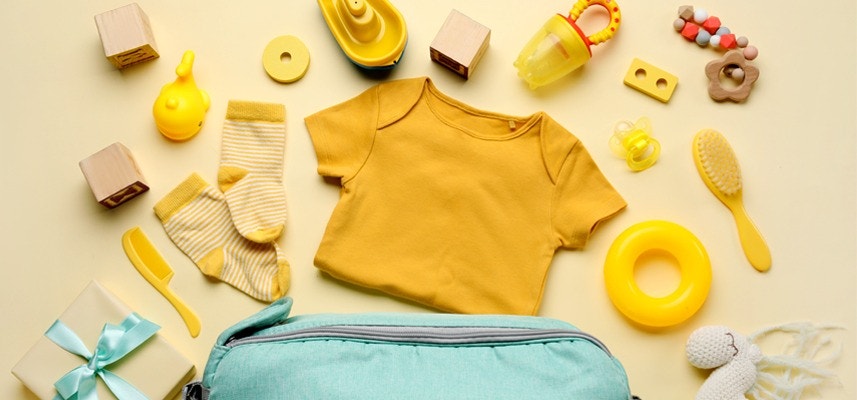Knowing what to look for in your next (or first!) breast pump can feel overwhelming. But don’t worry mama—we’ve got you. With so many incredible brands and options to choose from, you’re sure to find the pump that works best for you, and we’re here to help.
What to Consider When Picking Your Pump
Let’s start with a list of seven important questions to consider when shopping for a pump. Then, we’ll highlight product recommendations and share crucial information, such as make and suction strength. Finally, we’ll dive into detailed explanations of pumping essentials so you’ll be ready to pick your perfect pump.
1. Do you plan to direct breastfeed or exclusively pump?
Direct breastfeeding is when your baby nurses from your breasts. Most mothers who choose direct breastfeeding also pump as part of their feeding regimen and may need specific pump types—manual, standard, high-powered, or wearable—depending on the reason they are pumping. We’ll explore these reasons below.
Exclusive pumping means that you will pump and feed your baby your expressed breast milk without directly nursing at your breast. If you’re a mama who plans on exclusively pumping, a high-powered pump is the best choice.
2. Will you experience regular or occasional separation from baby?
Once you return to work, school, or other activities, you might experience regular separation from your baby. In cases of regular separation, a high-powered pump works well. Mamas with long commutes who want to pump in the car will benefit from a high-powered pump with a battery pack or rechargeable battery. Covered entities under the Pregnant Workers Fairness Act (PWFA) include public and private employers with 15 or more employees, unions, employment agencies, and the federal government. While these entities must provide you with a dedicated lactation space, wearable breast pumps can be used in instances where you require continuous, discreet pumping.
Occasional separation from your baby describes activities that happen less frequently or take up fewer than three hours at a time. This might include going to a doctor’s appointment or yoga class. You may find that you rarely need to pump for occasional separation, but a standard or manual pump works well if you do want to pump to leave milk for your baby.
3. Do you know your flange size?
Flange/breast shield sizes can impact your pumping comfort and effectiveness. All breast pumps come with 1-4 pairs of flanges in different sizes to help you find the best fit. In most cases, you don’t need to know your flange size before buying a pump.
You can get an idea of your flange size by measuring your nipples during weeks 38-39 of pregnancy, but you will get your most accurate measurement after 2 weeks postpartum. In case your pump didn’t come with the right size for you, you can either purchase the correct size flange or use a flange insert to modify the size of the flange.
If you need help with flanges or inserts, Aeroflow’s lactation consultants can help you find the perfect flange fit. We’re here to help you get your pumping journey off to the best start!
4. Will you need regular strength, hospital strength, or hospital-grade suction?
While most moms can use regular strength pumps, some may need or prefer a higher suction strength.
The term “hospital strength” can sometimes be misleading when referring to breast pumps. This is because manufacturers can label or describe their pumps as having hospital strength suction without any clear guidelines to mark the distinction. Yes, the suction may be stronger than a regular pump, but that doesn’t always mean moms will be able to express more milk. In fact, stronger suction can be uncomfortable for some moms.
When shopping, know that regular and hospital strength pumps share many similar features. These pumps are also intended for a single user for hygienic reasons, meaning only one mom should use them.
Hospital-grade pumps, on the other hand, are multi-user pumps. This is because they are used in the hospital or rented postpartum for use by different moms. Each mom will receive her own pump kit complete with flanges, bottles and tubes, but many moms will use the machine itself. Hospital-grade pumps help the small percentage of moms who struggle with low breast milk supply express more milk.
This type of pump isn’t available on the Aeroflow website. Insurance will only cover this pump as a rental with a letter of medical necessity, so it’s best to wait to see if you need a hospital-grade pump after your baby is born. For the best results, use it while collaborating with a lactation consultant.
5. Do you need an independent cycle and vacuum feature?
High-powered pumps come with an independent cycle and vacuum feature that has separate adjustments for cycle (speed) and vacuum (suction). When it comes to breast pumps, cycle describes the number of “sucks” the pump applies to the nipple per minute, while vacuum refers to the intensity of suction applied with each cycle.
Pumps with this feature can be customized to suit your preferences and help you produce an adequate milk supply when you are separated from your baby. These separate adjustments are preferred by most moms who exclusively pump or work full time.
Alternatively, manual, standard, and wearable breast pumps do not have a separate adjustment for both cycle and vacuum. Instead, these pumps typically have just one control or adjustment that will increase and decrease the cycle and vacuum in unison.
6. How does breast pump suction strength impact the pumping experience?
Some moms may feel strong suction strengths are better, but that’s not always the case. Research shows that when moms are using an electric breast pump, the yield of milk and milk flow rate are maximized if they use their own maximum comfortable vacuum. Since most of the milk is removed during the first two milk ejections, mothers should use their maximum comfortable vacuum strength during this period of pumping.
Breast pump suction strength is usually measured as mmHg, which is millimeters of mercury, the standard unit of measuring vacuum pressure. When buying a breast pump, you may notice mmHg in the product description. This number indicates the maximum suction level and will generally fall in the range of 220 to 350 mmHg. It’s best not to get hung up on these numbers though. Instead, focus on how the pump feels and finding that maximum comfortable vacuum.
Breast pumps have different strengths because every woman's breastfeeding experience is different, and one size does not fit all. Consider your options and find the strength that works best for you!
7. How breast pumping cadence impacts breastmilk production.
Sucking cadence is important because it mirrors baby's natural sucking through several phases:
- Let-down: Mimics when baby is vigorously sucking. When this happens, the nerves in your breasts are stimulated, signaling the release of a hormone called oxytocin. This release causes the small muscles that surround your milk-producing tissue to contract, which squeezes milk into your ducts.
- Expression: Mirrors when baby's sucking slows down as baby swallows the milk. This is sometimes called "suck, pause, swallow."
Some pumps have vacuum suction patterns that are meant to mirror the movements of an infant's tongue, Babies will typically alternate between a light and fast "flutter sucking," a deep and rhythmic sucking pattern, and occasionally suck with both intensity and speed when milk flow changes. Alternating back and forth between similar patterns on a pump can help to trigger multiple let-downs and express more milk.
If you think there is a problem with your suction, check the fit of your flange/breast shield. Finding the right fit is important, and if this is your first time using a pump, consult the brand’s fitting guide or see a lactation specialist to ensure your breast flanges are the right fit for your nipple size and shape, as well as areola density and fullness. Believe it or not, any variation or mismatch in either of these areas can impact the flange’s contact with the nipple or breast tissue, which could affect proper suction.
Exploring Pump Options
Now that you have some information about the different types of breast pumps and features available, you can begin searching for your pump!
Insurance companies differ when it comes to which pumps they will fully cover and which ones may require an additional, out-of-pocket expense. Where applicable, this extra fee is noted as an “upgrade fee” on the Aeroflow website.
Below, you’ll find a selection of our favorite pumps arranged by type.
Manual Pumps
Great for occasional pumping, manual breast pumps are an excellent, convenient option that don’t require electricity to operate. Use a manual pump when you have limited space, as a backup during power outages, or any other time when you might not be able to bring an electric pump with you.
To purchase manual breast pumps, you can use cash, your HSA (Health Savings Account), or FSA (Flexible Spending Account).
Motif Manual Silicone, Haakaa Silicone, or Medela Silicone
- Passive milk collection containers attach to your breast, usually while your baby is breastfeeding or when you are pumping from your other breast
- Create a continuous, gentle suction to remove excess milk
- Effective at relieving engorgement and collecting excess milk
- Lightweight and portable pump
Medela Harmony Manual, Lansinoh Manual, or Philips Avent Manual
- Activate milk production by using your hands to press and release the pump to remove milk
- Two-phase modes include letdown and expression, allowing you to control the pressure and speed of milk removal
- Effective at relieving engorgement and removing milk for occasional pumping
- Lightweight and portable
Electric Pumps
Electric pumps are great for occasional pumping, regular, and exclusive pumping. Plan ahead—these pumps must either be plugged into an outlet, operate on AA batteries, or an internal rechargeable battery. Here are some of the electric pumps we offer our mamas:
Medela Pump in Style with Maxflow
- Flange sizes available between 21mm-30mm
- 1.2 lbs (no screen, timer, or night light)
- External battery pack option that uses 8 AA batteries (for occasional use only. Pump works best when plugged into an outlet)
- Milk volume tracking through app; stats added manually
- 1-year manufacturer warranty
Lansinoh Smartpump 3.0
- Flange sizes available between 21mm-36mm
- 2 lbs, backlit LCD screen, and timer
- Internal rechargeable battery
- Milk volume tracking through app; stats added manually
- 1-year manufacturer warranty
Zomee Z2
- Flange sizes available between 15mm-32mm
- 2.4 lbs, backlit LCD screen, timer, and night light
- Internal rechargeable battery
- 2-year manufacturer warranty
Philips Avent (Corded or Rechargeable)
- Soft silicone flange for up to 30mm
- 1.8 lbs, backlit screen
- Internal rechargeable battery
- 2-year manufacturer warranty
Motif Duo
- Flange sizes available between 19mm-32mm
- 0.6 lbs, backlit LCD screen, and timer
- Internal rechargeable battery
- 2-year manufacturer warranty
High-Powered Pumps
Known for their strength and durability, high-powered pumps are effective for regular and exclusive pumping. Depending on the brand, some high-powered pumps can only be used while plugged into an outlet, and others have an internal rechargeable battery. These pumps feature an independent cycle and vacuum, as well as let-down and expression modes.
Motif Luna
- AC power adapter, no battery option
- Flange sizes available between 16mm-32mm
- 2 lbs, backlit LCD screen, timer, and night light
- 2-year manufacturer warranty
Spectra S2
- AC power adapter, no battery option
- Flange sizes available between 20mm-32mm
- 3 lbs, LCD screen, timer, and night light
- 2-year manufacturer warranty
Motif Luna with Battery
- Internal rechargeable battery
- Flange sizes available between 16mm-32mm
- 2 lbs, backlit LCD screen, timer, and night light
- 2-year manufacturer warranty
Spectra S1
- Internal rechargeable battery
- Flange sizes available between 20mm-32mm
- 3 lbs, LCD screen, timer, and night light
- 2-year manufacturer warranty
Wearable Pumps
Great for occasional pumping, as a second pump, or as a portable option, wearable breast pumps can complement a high-performance pump.
Wearable pumps are designed to be worn inside the bra for quiet, discreet, and sometimes hands-free pumping. Some come with collection cups and tubes that fit under your bra and shirt, while the motor rests in your pocket or on your waistband. You can also find some pumps with tubeless, self-contained units (cups with motors) that fit inside the bra.
All wearable pumps have letdown and expression modes with internal rechargeable batteries.
Medela Freestyle Hands-Free
- Milk volume tracking through app; stats added manually
- Connected by tubing
- Flange sizes available between 21mm-27mm
- 0.98 lbs, backlit screen, and timer
- 1-year manufacturer warranty
Elvie Stride
- Milk volume tracking and timer through app; stats added manually
- Connected by tubing
- Flange sizes available between 21mm-28mm
- 1.2 lbs
- 2-year manufacturer warranty
Willow Go
- Milk volume tracking and timer through app; stats added manually
- Free of tubing
- Flange sizes available between 15mm-27mm
- 0.8 lbs
- 1-year manufacturer warranty
Motif Aura Glow™
- 2 new custom modes designed by lactation professionals
- Free of tubing
- Flange sizes available between 15mm-24mm
- Designed with a built-in nightlight, and backlit LCD screen
- 2-year manufacturer warranty
Elvie
- Milk volume tracking and timer through app; stats added automatically
- Free of tubing
- Flange sizes available between 21mm-28mm
- 0.45 lbs
- 2-year manufacturer warranty
Willow 360
- Milk volume tracking and timer through app; stats added automatically
- Free of tubing
- Flange sizes available between 15mm-27mm
- 0.8 lbs
- 1-year limited manufacturer warranty
Breast Pumping Essentials for New Moms
Enhance your breast pumping journey with a few essential accessories from the Aeroflow site.
1. Breast Milk Storage Bags
Bottles have their time and place (immediate feeding sessions), but milk storage bags can help you properly and conveniently store breast milk to build a long-lasting supply for your baby. Milk storage bags take up less space in your freezer, are easier to stack, and they’re less prone to leaking or breaking, which keeps your precious liquid gold free of contamination and bad bacteria! They’re also pre-sterilized and disposable.
2. Nursing Pads
Mamas know—leaks happen! You might experience an unexpected letdown or leak at some point in your breastfeeding journey—this is normal! Disposable or washable nursing pads are designed to fit snugly inside your bra or nursing tank, providing you with discreet protection. If you plan to breastfeed, stock up on nursing pads and keep them within easy access.
3. Nipple Cream and Shields
Breastfeeding may come with temporary nipple pain or discomfort. Fortunately, creams created with simple skin therapy solutions and all-natural ingredients can nourish the skin and provide relief. Nipple shields can help with latching issues, inverted or flat nipples, and problems with overactive letdown. If you have any questions, speak with one of our lactation specialists. Your insurance might cover it, and we’re here to help!
4. Essentials Bundles
Feeling a little overwhelmed by all the pumping terms, accessories, and tools? No worries, mama, we’ve got you covered! Our essentials bundles below are specifically designed to provide pumping moms with key items to begin their breastfeeding and pumping journey! Choose from three great brands:
Motif Luna Pumping Essentials Bundle
Pump on the go! This kit contains 40 easy-pour breast milk storage bags, 2 milk collection containers with locking rings and lids, and a car adapter for travel.
Medela Pumping Essentials Bundle
This Medela kit has it all! Focusing on cleanliness, organization, and convenience, this kit includes 50 milk storage bags, a set of 6 milk collection and storage bottles, 6 reusable and Quick Clean micro-steam bags, and 30 Quick Clean wipes for use on breast pumps and accessories.
Spectra Pumping Essentials Bundle
Busy moms will love this Spectra kit, which includes 30 breast milk storage bags, a set of 2 wide-neck milk collection containers, and 2 small-cap bottle converters.
5. Breast Pump Bags and Backpacks
Not sure where to store your electric breast pumps, bottles, batteries, power adapters, and any additional portable products, pump parts, and supplies for breastfeeding? Don’t worry! We know it’s a lot to keep track of! Pick out a breast pump bag to store all your pumping essentials and any other items from your diaper bag. You can even add a smaller cooler bag and ice pack to safely store and keep your breast milk cool on the go.
6. Hands-Free Nursing Bras
Hands-free pumps are game-changers, and so are hands-free nursing bras! Multitasking mamas who need to save time and require additional mobility will benefit from hands-free nursing bras. Our collection includes soft, comfortable bras with cotton/elastic pieces that let you directly attach your breast shields.
Shop our full selection of pumping accessories and supplies here!
Making the Final Decision
Congrats, mama! You’ve made it to the end of our comprehensive guide on how to find and select the right pump for you! The important thing to remember is that every mom’s pumping journey is different, and what works for someone else may or may not work for you. This is your journey, and you should feel informed, supported, and prepared throughout the breastfeeding and pumping process.
If you’re regularly pumping in more than one place, or if you heavily rely on pumping to breastfeed, consider having a second backup pump. Note that insurance will not cover more than one pump per pregnancy, so you will have to pay for your second pump out of pocket.
If you have lactation or flange questions regarding your pump, your insurance may cover an appointment with an Aeroflow lactation consultant who can help you figure out the best pump for your breastfeeding goals. If you’re still undecided or unsure about which pump is best for you, please contact one of our Aeroflow breast pump specialists. We can also help you make a selection based on your health insurance coverage.









